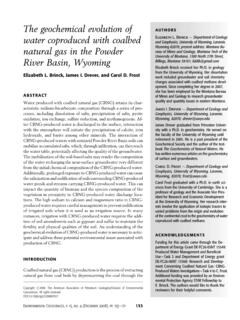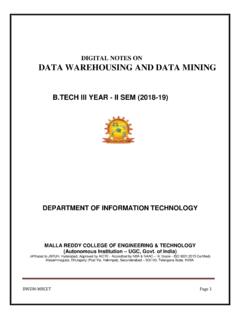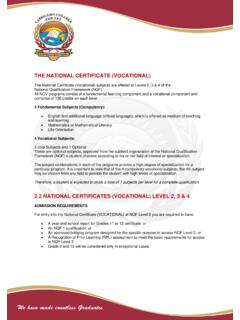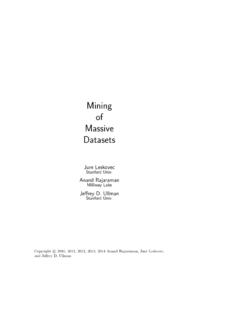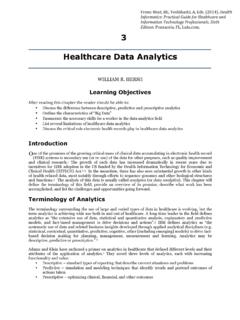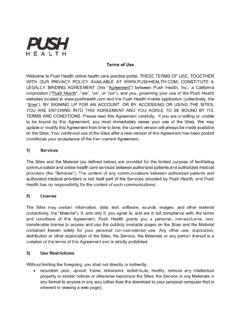Transcription of Introduction to Geostatistics | Course Notes
1 Introduction to Geostatistics Course NotesYe ZhangDept. of Geology & GeophysicsUniversity of WyomingDraft date January 12, Overview..iv1 Why Geostatistics ?.. Geostatistical Prediction.. Geostatistics versus Simple Interpolation.. Limitations.. This Class.. References.. Outline.. Homework, Grades, Tools.. Suggested Reading..122 Probability Theory Nomenclature and Notation.. Univariate Analysis.. Introduction .. Formal Definitions.. Random Variable Arithmetic.. Bivariate Analysis.. Introduction .. Bivariate Random Variables.. Bivariate Arithmetics.. Multivariate Analysis.. Linear Combination of Many .. Multivariate Arithmetics.. Gaussian Distribution.. Central Limit Theorem.
2 Chapter Project.. Suggested Reading..31iiiCONTENTS3 Spatial Conventional Analysis (Nongeostatistical).. data Posting.. Contour Map.. Symbol Map.. Indicator Map.. Moving Window.. Spatial Continuity Analysis (Geostatistical).. Experimental Variogram.. h-Scatterplot.. Variogram versus Univariate Statistics.. Higher Dimensions & Statistical Anisotropy.. Pure Nugget Variogram.. Standard Deviation of (h).. Irregular data : Variogram Search Envelope.. Exploring Anisotropy.. Spatial Continuity Analysis: Outline.. Chapter Project.. Suggested Reading..744 Variogram Basic Permissible Models.. Positive Definiteness.. Basic Variogram Functions.. 1D Variogram Model Statistical Isotropy.
3 Higher Dimensional Model Statistical Anisotropy.. Nested Model.. Model-Fitting Rules of Thumb .. Chapter Project.. Suggested Reading..895 The Problem of Estimation.. Nongeostatistical (Deterministic) Estimation.. Global Estimation.. Local Estimation.. Estimation Criteria.. Geostatistical (Probabilistic) Estimation.. Random Function Models.. Ordinary Kriging.. Cokriging & Collocated Cokriging.. Kriging with moving neighborhood.. Chapter Project.. Suggested Reading..119 CONTENTSiii6 Advanced Cross Validation.. Other Estimators.. Simple Kriging.. Indicator Kriging.. Block Kriging.. Geostatistical Simulation.. Cholesky Decomposition.. Conditional Simulation.. Sequential Gaussian Simulation (SGS).
4 Chapter Project.. Suggested Reading..1417 Final Overview.. What to hand in.. Additional Notes ..1488 Geostatistics Final Exam149ivCONTENTSThis is the lecture note written & assembled by Ye Zhang for an introductorycourse in 2010 GEOL 54463 CREDITSA-F GRADINGPre-requisite: Calculus I Linear Algebra; Probability & Statistics;Matlab programming languageLocation: ESB1006 Times: TTh (9:35 am 10:50 pm)Office hour: M(4:00 5:30 pm), F(3:00 4:30 pm), GE 220 Email: 307-766-2981 The syllabus: see : The lecture note do not include: (1) solutions to the ex-ercises and projects; (2) proofs to theories and equation will be presented only during lectures. So, please do not relyon the Notes for everything class attendance and participation arekey to doing OverviewGeoscientists often face interpolation and estimation problems when analyzingsparse data from field observations.
5 Geostatistics is an invaluable tool that canbe used to characterize spatial or temporal phenomena1. Geostatistics orig-inated from the mining and petroleum industries, starting with the work byDanie Krige in the 1950 s and was further developed by Georges Matheron inthe 1960 s. In both industries, Geostatistics is successfully applied to solve caseswhere decisions concerning expensive operations are based on interpretationsfrom sparse data located in space. Geostatistics has since been extended tomany other fields in or related to the earth sciences, , hydrogeology, hydrol-ogy, meteorology, oceanography, geochemistry, geography, soil sciences, forestry,landscape ecology. In this class, both fundamental development of geostatisticsand simple, practical applications in the earth sciences will be presented.
6 Ex-ercises and projects are designed to help elucidate the fundamental assignments will be given illustrating the applications of geostatisticsin the particular field of reservoir characterization and this class, we re concerned only with spatial analysis; temporal phenomena might bebetter understood in a separate class on time series 1 OverviewWhat is Geostatistics ? data analysis and spatial continuity modeling (Journel,1989). Establish quantitative measure of spatial correlation to be used for sub-sequent estimation and simulation (Deutsch, 2002). The following introductionand overview materials are based on compilation of several source materials (seefull references in Sec. ). Why Geostatistics ?Classic statistics is generally devoted to the analysis and interpretation of un-certainties caused by limited sampling of a property under study.
7 Geostatisticshowever deviates from classic statistics in that Geostatistics is not tied to apopulation distribution model that assumes, for example, all samples of a pop-ulation are normally distributed and independent from one another. Most ofthe earth science data ( , rock properties, contaminant concentrations) oftendo not satisfy these assumptions as they can be highly skewed and/or possessspatial correlation ( , data values from locations that are closer together tendto be more similar than data values from locations that are further apart).To most geologists, the fact that closely spaced samples tend to be similar isnot surprising since such samples have been influenced by similar physical andchemical depositional/transport to the classic statistics which examine the statistical distributionof a set of sampled data , Geostatistics incorporates both the statistical distri-bution of the sample dataandthe spatial correlation among the sample of this difference, many earth science problems are more effectively ad-dressed using geostatistical methods.
8 As stated by Marc Cromer (inGeostatis-tics for environmental and geotechnical applications, 1996, ASTM International,edited by Rouhani et al.):Geostatistical methods provide the tools to capture, through rigorous exami-nation, the descriptive information on a phenomenon from sparse, often biased,and often expensive sample data . The continued examination and quantitative12 CHAPTER 1. OVERVIEW rigor of the procedure provide a vehicle for integrating qualitative and quantita-tive understanding by allowing the data to speak for themselves . In effect, theprocess produces the most plausible interpretation by continued examination ofthe data in response to conflicting interpretations.. The application of geo-statistics to environmental problems ( , groundwater contaminant cleanup)has also proven a powerful integration tool, allowing coordination of activitiesfrom field data acquisition to design analysis.
9 For example, data collection isoften incomplete, resulting in uncertainties in understanding the problem andincreasing the risk of regulatory failure. While this uncertainties can often bereduced with additional sampling, the benefits must be balanced with increasingcost.. Thus, Geostatistics offers a means to quantify uncertainty,while leveraging existing data to support sampling Geostatistical PredictionThe goal of Geostatistics is to predict the possible spatial distribution of a prop-erty. Such prediction often takes the form of a map or a series of maps. Twobasic forms of prediction exist:estimation( ) andsimulation( ). In estimation, a single, statistically best estimate (map) of thespatial occurrence is produced.
10 The estimation is based on both the sampledata and on a model (variogram) determined as most accurately representingthe spatial correlation of the sample data . This single estimate or map is usu-ally produced by the kriging technique. On the other hand, in simulation, manyequal-likely maps (sometimes called images ) of the property distribution areproduced, using the same model of spatial correlation as required for between the alternative maps provide a measure of quantifying theuncertainty, an option not available with kriging has played an increasing role in both groundwater hydrologyand petroleum reservoir characterization and modeling, driven mainly by therecognition that heterogeneity in petrophysical properties ( , permeability andporosity) dominates groundwater flow, solute transport, and multiphase migra-tion in the subsurface.
